#urban homestead
Text
Garden Report & Frugal Living 23.03.25
Just a quick note:
None of the spinach, carrots nor radish have come up this month. By the look of the bed, I suspect little birds. Following planting by moon failed there so now for another attempt with the garlic (root crop) and try to pay attention to her another batch in when it's not 'favourable'. Pulled a very juicy leek while I was there to ad to soup.
The viking potatoe plants are huge under the hazel hedge. Gathered few seed potatoes the were forced up in one grow bed, tossed them in potato barrel and covered with soil.
I hope to be well enough and the weather fine and I will start/attempt to revive the poor Asian pear ( char/wood ash, alphalfa pellets, glacial dust and nettle and kelp tea). Some of the wood is wick/alive so hoping to pull her through. Saw Paul also hit with spray part of the pomegranate and again at the blackberries.
Frugal living tip: compost or plant in cardboard box (non-waxed). This is another experiment that just might work for you too. This autumn I composted apples, aviary muck and leaves in a cardboard box under a tree. I hope to plant in it this spring. Side note though, I did put it in a large plastic box that had holes in the bottom to drain. I wanted to be see all around to see how this went/see the bottom too. I've done this before with double walled cardboard/ two inserted and it last one season in the land of eternal fog's 'full sun's. Container gardening doesn't have to be fancy pots and mini grow boxes, get creative, just allow enough for root growth and don't use toxic containers.
#catholic gardener#garden#gardening#Urban homestead#permaculture#edible landscaping#container gardening#nursing sick trees#when people try to kill your garden#planting#Spring#sign of the moon planting#garlic#garden report#frugal living
4 notes
·
View notes
Text
I’m considering a vertical garden.
At least partially, but so far, I’m having a difficult time figuring out how to design this. I would like to, ideally, be able to combine the design of a plant box 42” tall, with “pallet gardens”, which look a bit like this
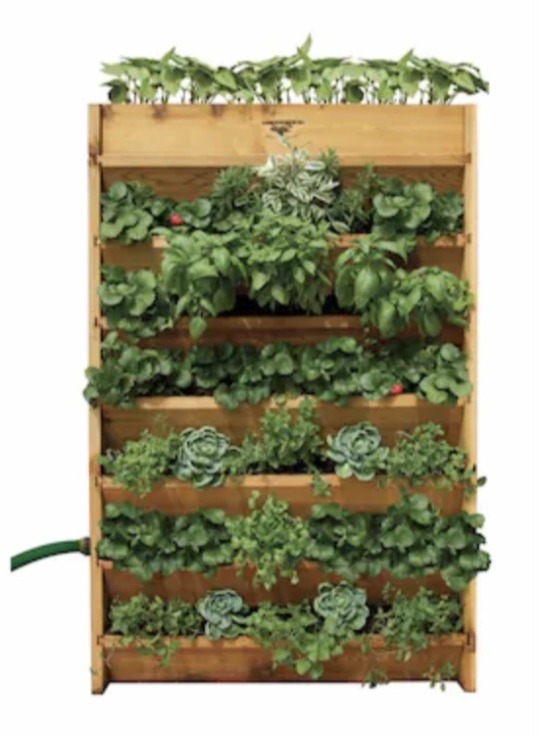
That way I could grow my small root veggies (like baby carrots) up top this would make them protected from ground critters since we primarily have rabbits here, and other things like herbs on the side. It would also come in handy to have an empty version on the other side to hold produce or supplies (shears, tools, etc) so it’s all right there for ease of access. I’m deciding if planting peppers is going to be worth it in the end, considering not many in the house use them - but I could also sell them.
I’m also kind of considering chickens, but have heard quail are easier to raise and keep in general. I’ve been checking out some really neat coops and stuff, and I’m curious if there’s any value to quail versus chickens. Gonna have to check it out, I guess.
Note to self: check out if natural wildflowers or a clover lawn can have an impact on growing vegetables and fruit. Also investigate how to start a compost pile - is there a way to revive one that was already there? When we bought the property there was a large compost pile near the back corner of the fence. I wonder if I can simply “revive” that one?
9 notes
·
View notes
Text
Home Hens
Trying this today. Growing some extra grains for the couple of backyard hens we've gotten. We've accumulated lots of dried beans through-out the years so lets see if any of them sprout.
3 notes
·
View notes
Text
Building my first mushroom garden
Yesterday was sunny and 70 degrees, the last pleasant day we'll see for a while (maybe until spring), and I had two PTO days that I had to use before the end of the year and a big outdoor project to work on, so naturally I took the day off work and put together my mushroom garden!
I hadn't been expecting to make the mushroom garden this fall, but then the city trimmed a few trees at the end of the block and left the debris behind, so I've been going over there with my collapsible canvas wagon and loading it up with branches whenever I have the time and energy to do so. The smaller branches got cut down for kindling, but I also managed to bring home a few larger logs. The largest are from an elm that had a dead arm; that's not ideal for mushrooms, which do best in wood that was cut live, because it has more moisture and is less likely to be infected with different fungus already. If the fungus you plant have to battle another fungus already in the wood, they're less likely to be able to put energy into producing mushrooms. But I also got some 3"-4"-diameter maple branches that came off a live tree—they must've been getting close to the power lines—which are a great size and a good tree species for many mushrooms.
Also, very fortunately, I recently cleaned out the garden shed and found that the previous owners—Bless them!—left us a pair of sawhorses. I ate a hearty breakfast of eggs and cornbread and got outside a little before 9 a.m. I set up by the vegetable garden because there's an outlet attached to the old clothesline support, so I could use my plug-in drill and not worry about batteries. All the smaller logs you see below are green maple wood; the larger two on the bottom-right are the dead elm logs.

I set up my supplies on a small folding camp table. In the bags are plug spawn—small wooden dowels, same as you'd use for putting together a bookcase, that have been thoroughly infected with the desired fungus. I chose two cold-producing, relatively easy-to-grow wild edibles that I haven't managed to find on my own: Lion's Mane and Blue Oyster. The round container of white stuff is plug wax, a soft wax that you smear over the plugs once they're in the logs to prevent moisture from escaping or other infectious agents from entering. I bought the plugs and wax from Field and Forest Products. They also provided very useful printed instructions.
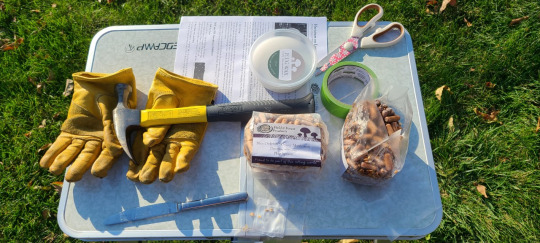
Step one was drilling lines of holes in a diamond pattern, about 3-4" between holes and 2" between rows. That's around 55-80 holes per log! I placed a bucket underneath to catch the wood shavings so I can use it for firestarter or other projects later.

Next, each hole got a plug hammered in. They were a tight fit! This log was particularly tricky because I had to work over a large scar where a branch had broken off years ago.

Finally, I used the butter knife to scrape up some wax and then used my fingers to spread it over the plugs. My legs were getting tired by the time I took this photo, so I tried sitting down and balancing the log on my legs while I worked. It didn't work out so great, and I got some wax on my jeans. Oh, well!

When I finished with all the good, green maple logs, I still had 102 plugs of blue oyster, so I decided to try inoculating one of large elm logs. The largest didn't show as much sign of rot, and I'm hoping that the number of plugs I put in it will be able to overwhelm anything already growing in there, but I'm treating that one as purely experimental and not really expecting anything from it.
I worked on that last log in the waning light of 4:30 pm and it was pretty dark by the time I finished, but there was enough city-light to set the logs into the mushroom garden. It's a narrow strip of land on the north side of the garage, which is well-protected and receives little sun. The previous owners had a few hostas and other shade-friendly flowers there, but I removed the largest to the front-yard flower garden and plan to give away the others next spring, when I plant additional edible forest species there (if anyone reading this has a source for wild ramps, hmu!). In preparation for growing mushrooms, I collected bags of leaves that my neighbors put out with their trash and spread about 4" of leaf mulch there to help hold in moisture for the logs to wick up. I also dug about 4-6" down into the soil to anchor the logs and give them more contact with moist soil. I think there's a slight risk there of something from the soil getting into the logs—everything I've read about growing mushrooms is trying to balance giving the logs moisture with prevent infection—but since I'm growing in an urban area, whereas most mushroom farmers are growing on forested land, I'm sure there are fewer fungi in the soil for me to worry about. For the smaller logs, I leaned them up against the garage—I read that leaning them against a tree is recommended for small forest gardens (larger ones create log-cabin-style stacks)—and for the largest, I dug a little deeper and stood it on end. Here's a photo of the finished garden that I took this morning as I was leaving for work:
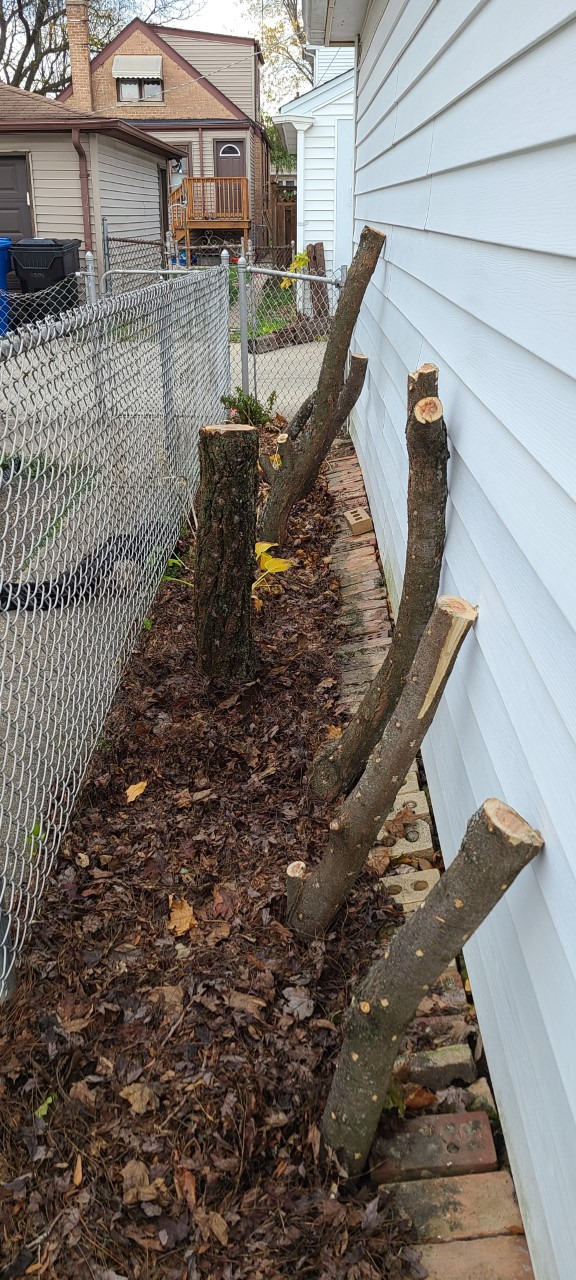
And now, we wait! Depending on the weather conditions and this specific wood, the smaller logs could take up to a year to start producing, and I expect the larger log to take a year or maybe two, if it ever produces at all. But once they start, each log should be good for 3-5 years of harvests! And I haven't looked into this yet, but I think I should be able to use the spent logs to inoculate fresh ones, if I still want to keep growing the same type of mushrooms by then.
I'm really happy to have this done already, and with free wood! I'll have that much more time and energy to focus on other gardening projects next spring, and these logs might even start producing by then.
3 notes
·
View notes
Text


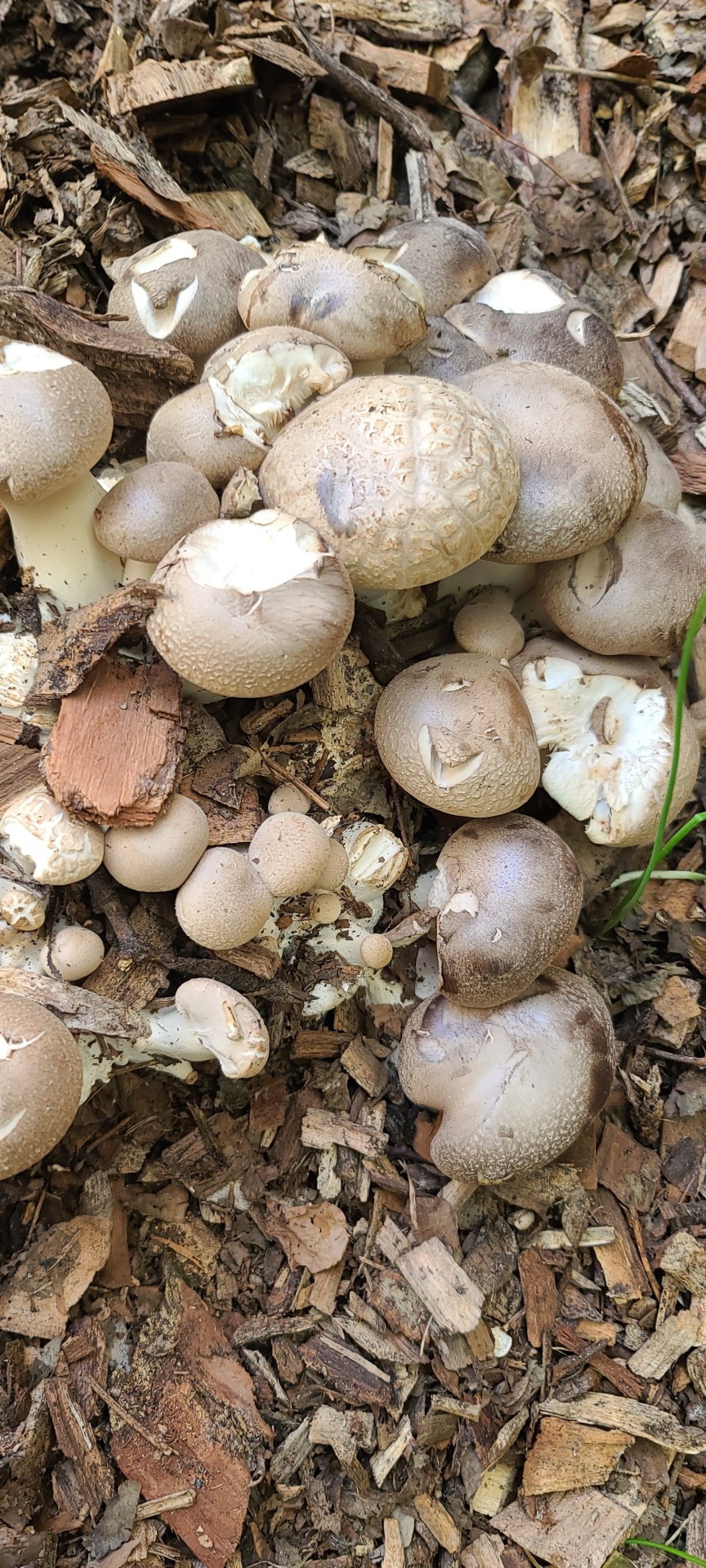
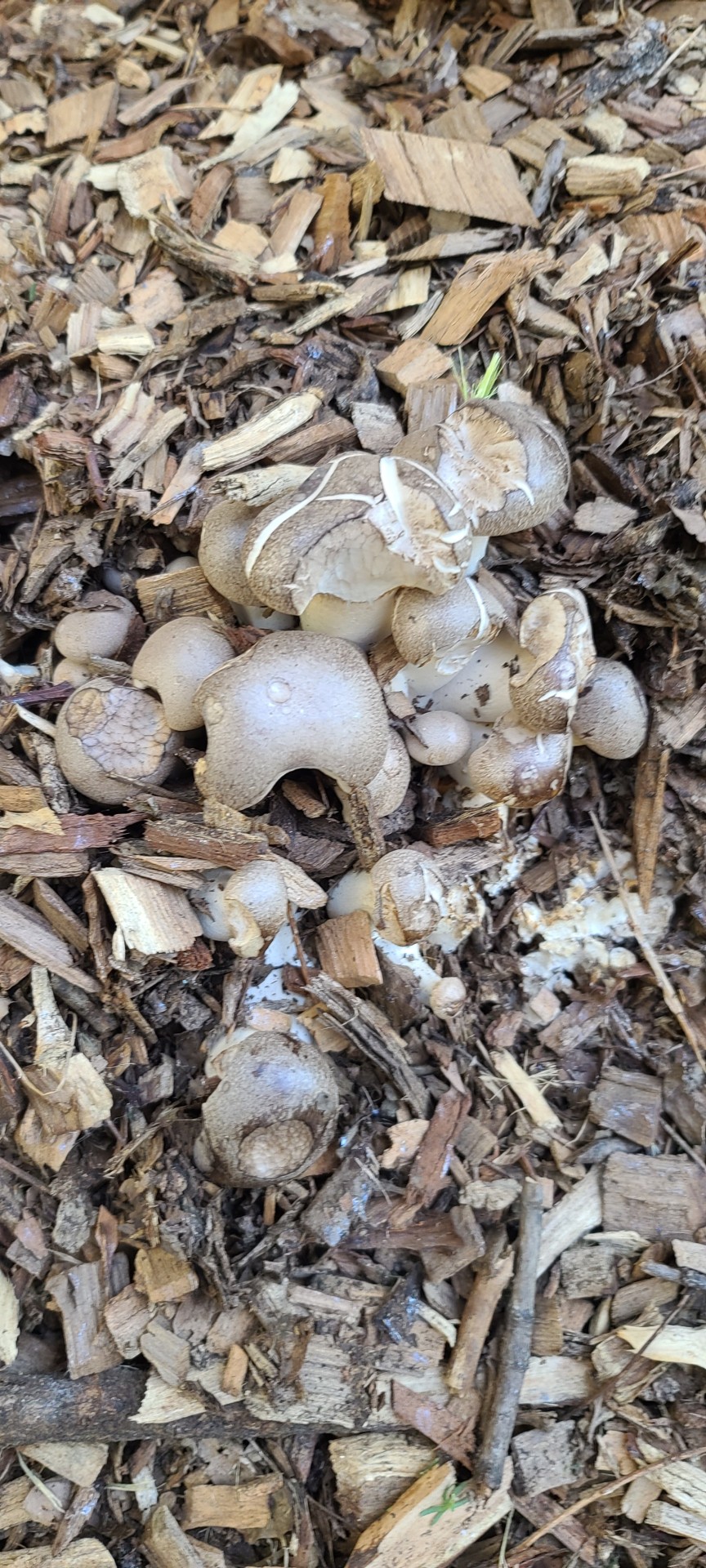
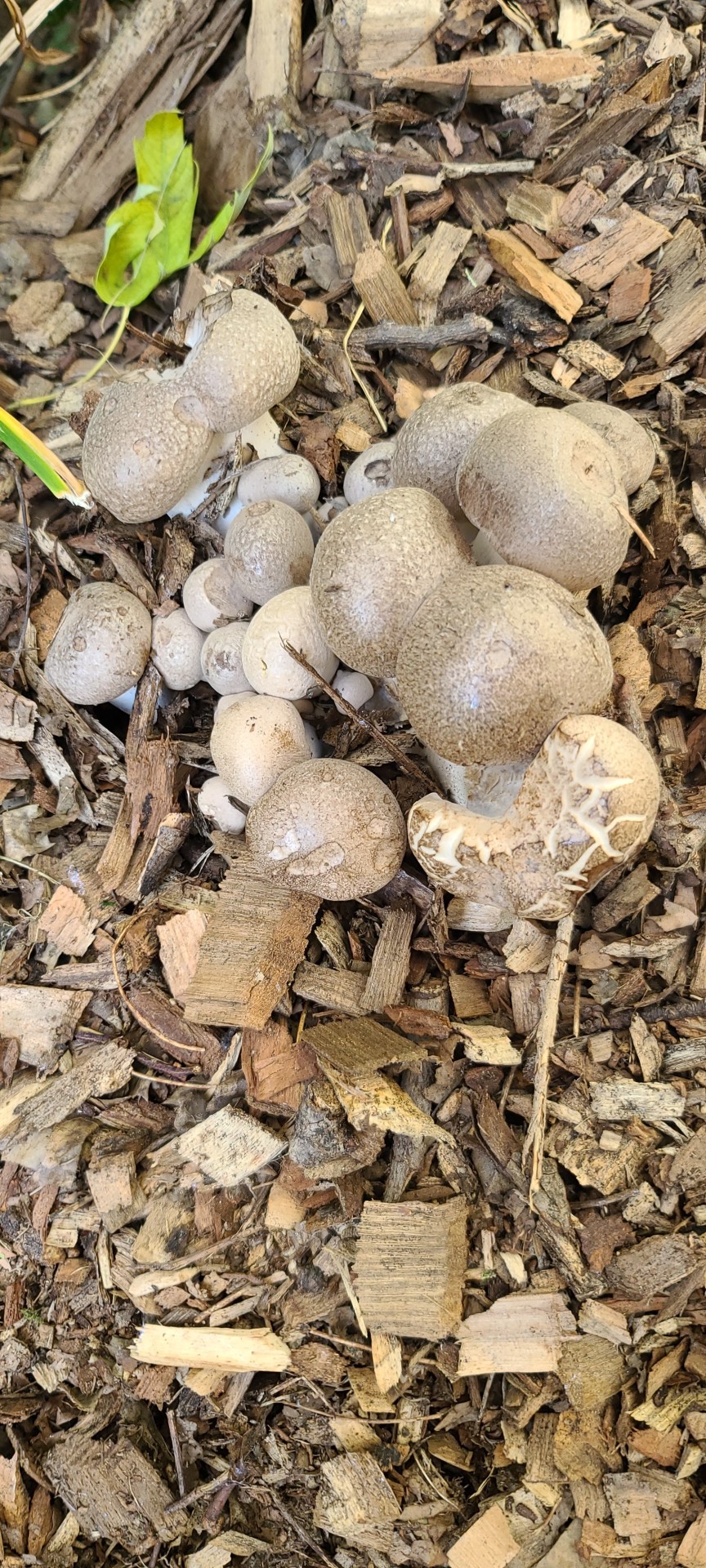

As much as I adore the fungal beauties I see here on Tumblr, I love the ones I grow and find in the world even better. These are all from my urban homestead, and I'm so excited about them!
#mushrooms#chestnut mushrooms#king oyster mushrooms#rot#fantastic fungi#fungilove#fungi#urban homestead#gay gardener#gay pagan#gay witch#queer pagan#queer witch#grey dove oyster#cottage core#cottagecore#forest core
6 notes
·
View notes
Text
friendship ended with [ENGLISH KNITTING]. now [CONTINENTAL KNITTING] is my new best friend.
this brought to you by drunkenly looking up left handed knitting to teach a classmate, and realizing that in the 12 years i've been knitting, i've never bothered to learn how to knit continental. and boy is it wild. hold a bit of yarn at tension and use the working needle to yank it through the stitch? rather than throwing the yarn across the needle and tensioning it by hand after you've made the new loop? witchcraft.
3 notes
·
View notes
Video
youtube
They Built a Gorgeous Tiny House, Urban Food Forest & Mini Village
Meet Sarah & Kevin, who built an amazing Victorian farmhouse style 10 ft wide tiny house in their own backyard. They also created an urban homestead tiny home village with lush permaculture gardens. All residents enjoy communal spaces with few rules & privacy of their own homes.
Thanks to our sponsor! Download the FREE Upside App: https://upside.app.link/tinyhouse to get $5 or more cash back on your 1st purchase of $10 or more.
#youtube#tiny house#tiny house community#tiny home#tiny house tour#tiny house village#tiny house movement#tiny home community#urban homestead#permaculture#food forest#urban ecovillage#tiny house living#alternative living#simple living
5 notes
·
View notes
Text
Homemaking, gardening, and self-sufficiency resources that won't radicalize you into a hate group

It seems like self-sufficiency and homemaking skills are blowing up right now. With the COVID-19 pandemic and the current economic crisis, a lot of folks, especially young people, are looking to develop skills that will help them be a little bit less dependent on our consumerist economy. And I think that's generally a good thing. I think more of us should know how to cook a meal from scratch, grow our own vegetables, and mend our own clothes. Those are good skills to have.
Unfortunately, these "self-sufficiency" skills are often used as a recruiting tactic by white supremacists, TERFs, and other hate groups. They become a way to reconnect to or relive the "good old days," a romanticized (false) past before modern society and civil rights. And for a lot of people, these skills are inseparably connected to their politics and may even be used as a tool to indoctrinate new people.
In the spirit of building safe communities, here's a complete list of the safe resources I've found for learning homemaking, gardening, and related skills. Safe for me means queer- and trans-friendly, inclusive of different races and cultures, does not contain Christian preaching, and does not contain white supremacist or TERF dog whistles.
Homemaking/Housekeeping/Caring for your home:
Making It by Kelly Coyne and Erik Knutzen [book] (The big crunchy household DIY book; includes every level of self-sufficiency from making your own toothpaste and laundry soap to setting up raised beds to butchering a chicken. Authors are explicitly left-leaning.)
Safe and Sound: A Renter-Friendly Guide to Home Repair by Mercury Stardust [book] (A guide to simple home repair tasks, written with rentals in mind; very compassionate and accessible language.)
How To Keep House While Drowning by KC Davis [book] (The book about cleaning and housework for people who get overwhelmed by cleaning and housework, based on the premise that messiness is not a moral failing; disability and neurodivergence friendly; genuinely changed how I approach cleaning tasks.)
Gardening
Rebel Gardening by Alessandro Vitale [book] (Really great introduction to urban gardening; explicitly discusses renter-friendly garden designs in small spaces; lots of DIY solutions using recycled materials; note that the author lives in England, so check if plants are invasive in your area before putting them in the ground.)
Country/Rural Living:
Woodsqueer by Gretchen Legler [book] (Memoir of a lesbian who lives and works on a rural farm in Maine with her wife; does a good job of showing what it's like to be queer in a rural space; CW for mentions of domestic violence, infidelity/cheating, and internalized homophobia)
"Debunking the Off-Grid Fantasy" by Maggie Mae Fish [video essay] (Deconstructs the off-grid lifestyle and the myth of self-reliance)
Sewing/Mending:
Annika Victoria [YouTube channel] (No longer active, but their videos are still a great resource for anyone learning to sew; check out the beginner project playlist to start. This is where I learned a lot of what I know about sewing.)
Make, Sew, and Mend by Bernadette Banner [book] (A very thorough written introduction to hand-sewing, written by a clothing historian; lots of fun garment history facts; explicitly inclusive of BIPOC, queer, and trans sewists.)
Sustainability/Land Stewardship
Braiding Sweetgrass by Robin Wall Kimmerer [book] (Most of you have probably already read this one or had it recommended to you, but it really is that good; excellent example of how traditional animist beliefs -- in this case, indigenous American beliefs -- can exist in healthy symbiosis with science; more philosophy than how-to, but a great foundational resource.)
Wild Witchcraft by Rebecca Beyer [book] (This one is for my fellow witches; one of my favorite witchcraft books, and an excellent example of a place-based practice deeply rooted in the land.)
Avoiding the "Crunchy to Alt Right Pipeline"
Note: the "crunchy to alt-right pipeline" is a term used to describe how white supremacists and other far right groups use "crunchy" spaces (i.e., spaces dedicated to farming, homemaking, alternative medicine, simple living/slow living, etc.) to recruit and indoctrinate people into their movements. Knowing how this recruitment works can help you recognize it when you do encounter it and avoid being influenced by it.
"The Crunchy-to-Alt-Right Pipeline" by Kathleen Belew [magazine article] (Good, short introduction to this issue and its history.)
Sisters in Hate by Seyward Darby (I feel like I need to give a content warning: this book contains explicit descriptions of racism, white supremacy, and Neo Nazis, and it's a very difficult read, but it really is a great, in-depth breakdown of the role women play in the alt-right; also explicitly addresses the crunchy to alt-right pipeline.)
These are just the resources I've personally found helpful, so if anyone else has any they want to add, please, please do!
#homemaking#homemaking resources#gardening#urban gardening#self sufficiency#self sufficient living#sustainability#sustainable living#homesteading#nontrad homemaker#nontrad housewife#urban homesteading#solarpunk#cottagecore#kitchen witch#kitchen witchcraft#crunchy to alt right pipeline#book rec#book recommendations#resource#long post#mine#racism tw#racism mention#transphobia tw#transphobia mention
1K notes
·
View notes
Text

Bring back the victory gardens ✌️
#victory garden#garden#self sustinable#self sufficiency#urban homesteading#homesteading#gardening#vegetable gardening
909 notes
·
View notes
Text
Garden Report & Frugal Living 24.03.20
Happy Spring! It's official; as I was gazing out the window, a pair of swallows appeared. Such a welcomed sight.
Thank you for prayers and well wishes. It really is helpful and encouraging when people care. Because I've been bedbound I don't have much to report. The Burbank plum is slowly coming into bloom. I can see the sparrows who insist on living the thug life, land in its way branches and start ripping up the blossom, causing clouds of shredded petals to flutter to the ground. These feathered hooligans also fight not just amoung themselves but other little birds that want to come to the suet basket. The kids started bringing the basket in before dusk due to the ugliest monster rat that labourously claws up the shepherd 's hook to feed.
The little red flesh apple is getting ready to flower. I saw the buds are swelling and the leaf tips are ready to go. The Easter lilies are starting to unflurl -- the should be some ready for the holiday. I can't see much else without a proper walk about. I'm afraid my Asian pear may have been poison as it should have not only have bloomed, it should be leafed out by now. I've had a child go out to my plant by the moon experiment and the report back was that it had been rototilled by the birds. I'm hoping they looked in the wrong grow box but the report back is par for the course as I did not get it covered with ag cloth.
The hens are laying irregularly but several times a week each... we've gotten a little over a dozen eggs in the last few weeks. The are begging to be let out but I have no one to hensit; they are ravenous for greens and to hunt.
Fugile tip: I'm sorry but I can't think. If you have one or several Please comment as I would love to hear!
Heres to a beautiful Spring, good health (yours & mine), more gardening and enjoying the simple things in Life.
#catholic gardener#gardening#Urban homestead#permaculture#Edible landscape#hens#fruit trees#Spring#flowers#frugal living
3 notes
·
View notes
Text
Good afternoon everyone~
It's cold, windy and it's been raining on and off all day but I finally got out to harvesting the sweet potatoes.
I started with the 'L' bed.

This is the bowl I'll be using to collect the spuds for this deep raised bed.
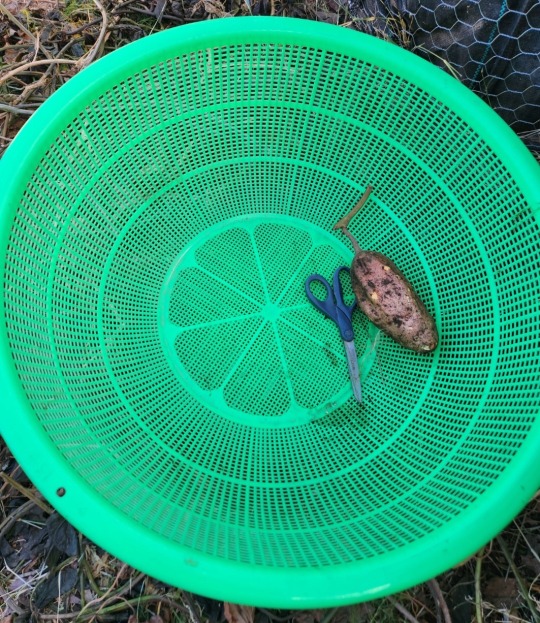
Those are full size scissors btw. This is the absolute biggest strainer I own and when I do harvesting I'm always glad to have it! Helps with carrying and washing off dirt outside so much easier!

It was pretty fun digging round for the spuds and to be honest the size and shape of some of them really suprised me!

For some size comparison, my hand is right on top of them.
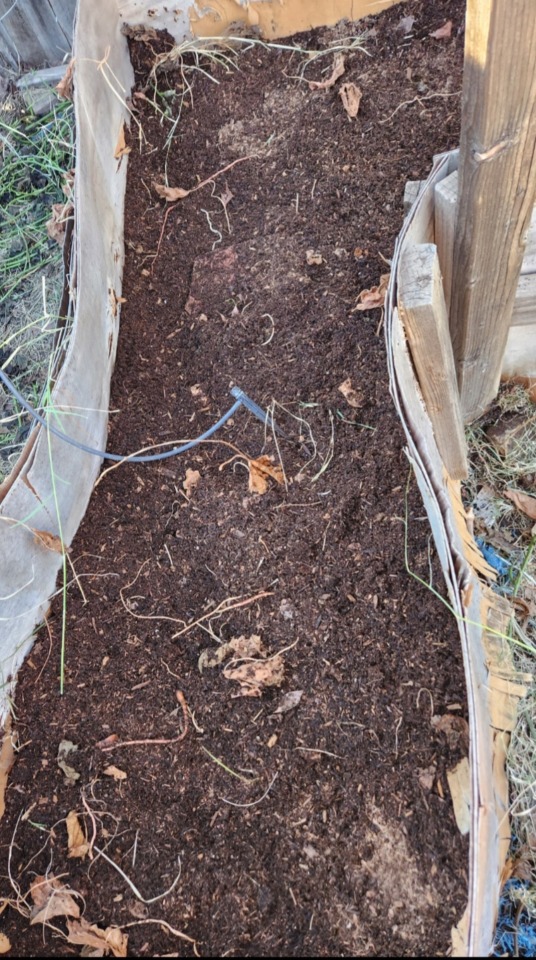
All cleaned out!
Next was the little round bed in the corner. I wasn't really expecting much, but it filled the bin pretty good.

I've washed the spuds off and am letting them dry off but I'll be finding a spot inside soemwhere to let them sit and cure for a bit of time. (I probably will let them cure until end of febuary.)
Curing your sweet potatoes is what makes them sweet, you can eat them right away but their said to be bitter. (I will be trying 1 potato to see if this is true!) Curing them should be done for at least 2 week in a cool dry space (around 80*f). If you under 80*f space add 7 more days.
I thought this was neat and wanted to share it. since I've not seen a sweet potato grown or dug up before

I wasn't expecting so much differance in spud size from one single root.
And one last pic,
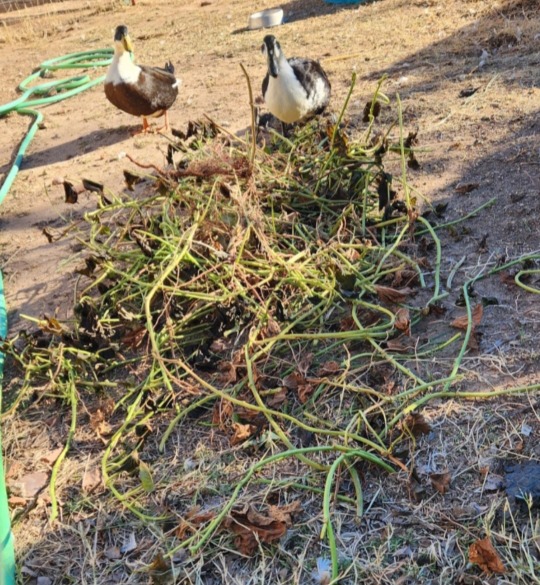
The ducks quite like the greens, while there's not much left of it I'm going to leave the vines a couple days so they can use it as enrichment/snack opportunity.
Weigh in on the spuds later!
🍠🌱Happy Homesteading and Harvesting!!
🌱🍠
1.11.2024
#self sufficient living#homesteading#thestudentfarmer#studentfarmer#self sufficiency#food#garden#gardening#low waste#duck#sustainability#smalls scale differences#urban animal keeping#urban biodiversity#urban homesteading#urban gardening#urban farming#grow what you can#simple plants to grow#multipurpose crops#right to grow#human right to clean food#right to grow food#raised garden beds#start to finish#will it grow?#food sovereignty#whole foods#first time growing#going green as can be
59 notes
·
View notes
Text
~ Welcome to the August Garden~

It is now the month of red! Look at this morning’s harvest.
My summer sown broccoli are looking so good. It’s my first attempt, so I’m very excited to see if we get any florets before the first frost.

My first cabbage is also almost ready to be harvested and the tomatoes are giving us a steady stream of fruits now. Hopefully they will keep it up well into September.

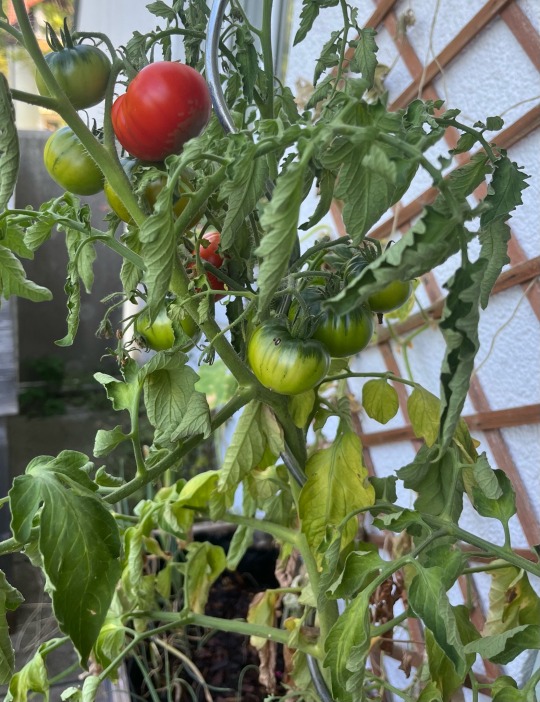
We are getting to the end of cucumber season. All that’s left of my plants are these little deformed ones, but I bet they will still be absolutely delicious!
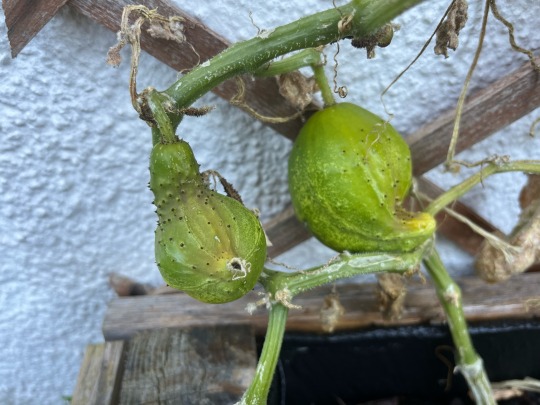
As for some color, my yellow nasturtiums have finally started blooming en masse. Next to them you can see that the marigolds are also still going strong 💪🏻
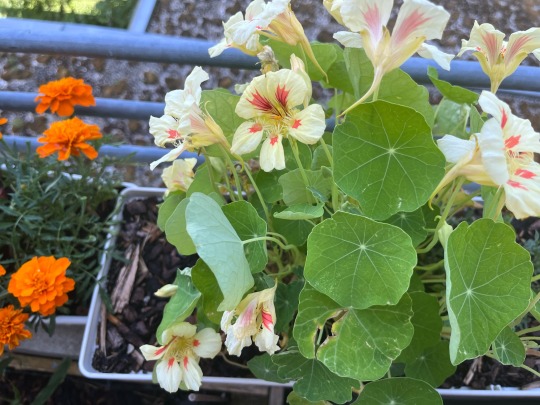
Next month will probably look a lot more bare, as our first frost date is at the beginning of October.
Until next time,
~L
#cottagecore#farmcore#balcony garden#urban farming#gardening#homesteading#vegetables#grandmacore#homestead
72 notes
·
View notes
Text
Operation Lawn Replacement

All the little reddish seeds that are starting to sprout are mini white clover seeds. I threw fistfulls of these seeds all over my front yard a day ago, and they're already starting to sprout after the rain we've had.
As my update on my last post says, I recently bought a house. My first one ever. *excited squealing* One of the first things I'm doing is replacing the lawn with mini clover. This will probably irritate my neighbors, but since there is no HOA (I wouldn't have bought it if it did), I don't care. There are several reasons why I am doing this:
• mini clover only grows about 6 inches tall max, so it does not require mowing
• clover, being a legume, is a nitrogen fixer, which helps enrich the soil, and doesn't require massive amounts of fertilizer to stay green
• clover is broad leafed, so is better at shading out other undesirable plants/weeds, which means it doesn't require massive amounts of herbicides to create a uniform lawn (I am not advocating for monocultures here, but if that's what you want, then clover does it better than grass)
• clover emerges from dormancy sooner in the spring, stays green in the fall/winter longer, and requires less watering than grass, so it looks nicer when everyone else's lawns are dead and brown due to changing seasons or drought
• clover produces beautiful little white flowers that bees and butterflies love, which supports and attracts these pollinators to other areas of the garden
• clover leaves and flowers are edible
I'm sure there are other reasons I'm forgetting, but I think this is enough reason to lose the grass with its shallow roots and intensive care in favor of something simpler and prettier.
13 notes
·
View notes
Text
FRONT GARDEN UPDATE 11/29/2023
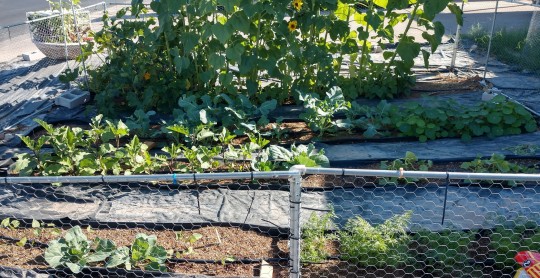
Full side view

Row 1= a pumpkin, variety of sunflowers and Valor beans
The pumpkin has two fruits on it at the moment! I'm gonna post a few pics of what it looks like currently a little further down.
For the sunflowers we just mixed a bunch of different ones together so there's some Mammoth, Boss (black oil sunflower) and some stuff we had left over from the last sunflowers we grew!
Row 2 = nasturtiums further away and cabbage

A little view of row 2
Row 3= Armenian cucumbers and egg plants
The Armenians aren't spreading out too much but that's more our fault than the plants, it's not in a super sunny spot and it tends to do better when it's slightly sunnier spot in the winter.
Row#4= more valor beans closer with some remnants of cabbage, carrots and radish.


Close up of the pumpkins!
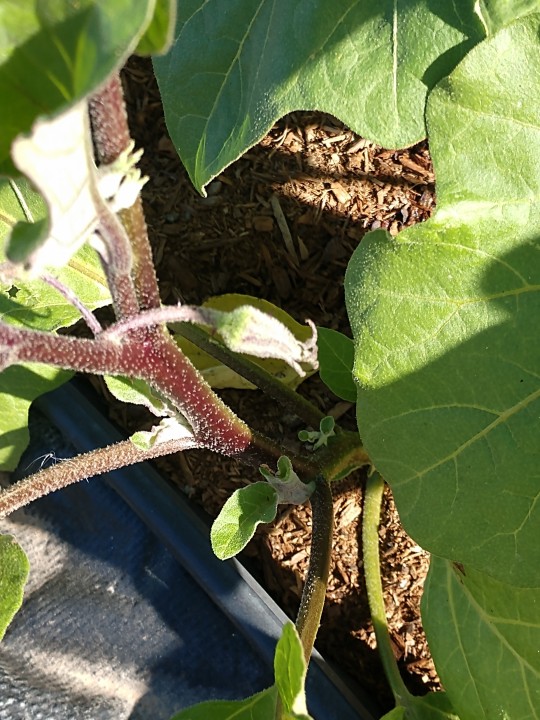
One of the eggplants is starting to show signs of getting flowers/fruit.

A valor bean on the plant
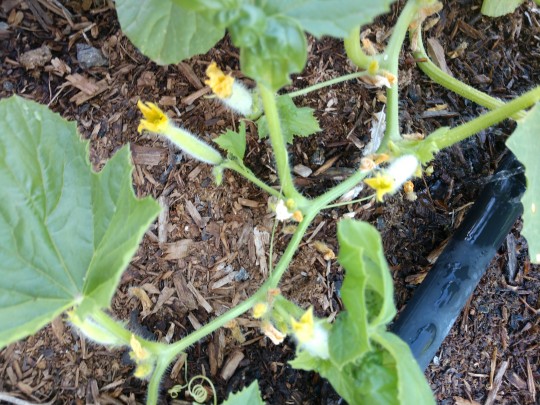
While they aren't really branching out one of them does have a lot of little cucumbers starting!


And some bees on some of the blossomed sunflowers!
#gardening#letsgogardening#homesteading#urban homesteading#self sufficient living#garden#urban gardening#potted plants#thestudentfarmer#letsgointhegarden#lets go gardening#eggplant#carrot#sunflowers#sunflower#bee#garden update#frontyardupdate#food rights#food is a human right#beans#variety bush bean#valor beans#cabbage#nasturtium#edible#edible flowers#edible plants#anyone can garden#raised garden beds
21 notes
·
View notes
Text
Creating a Cozy and Chaotic Haven: Welcome to The ADHD Homemaker
Home is where the heart is, and as homemakers, we have the incredible privilege of shaping and nurturing that heart. Welcome to The ADHD Homemaker, your online guide to the art of homemaking. Whether you're a seasoned homemaker or just beginning your journey, you've found a welcoming space where we celebrate the magic of home.
The ADHD Homemaker isn't just a blog; it's a community of people who are passionate about learning more about homemaking and finding peace within the chaos of this crazy world. Here, we explore the many facets of homemaking, from organization and decor to cooking, cleaning, and everything in between.
I believe in the transformative power of homemaking. It's not just about keeping a tidy house; it's about cultivating a nurturing environment that reflects your personality and values. Homemaking is an art, a labor of love, and we're here to help you embrace it with enthusiasm.
This blog is your resource for all things homemaking, offering a wealth of ideas, advice, and inspiration. In the upcoming posts, we'll dive deep into various aspects of homemaking, including:
Home Decor: Discover tips and tricks for decorating your living spaces to reflect your style and create an inviting ambiance.
Cooking and Recipes: Explore delicious recipes, cooking techniques, and meal planning ideas for all skill levels.
Organization and Cleaning: Learn how to keep your home tidy and efficient, making daily life smoother and more enjoyable.
DIY Projects: Get creative with DIY projects and crafts to add a personal touch to your home.
Homemaking is a labor of love, and it's even more rewarding when shared with a like-minded community. We encourage you to share your insights, ask questions, and engage with us and fellow homemakers. Together, we can make the journey of homemaking more enjoyable and fulfilling.
I am thrilled to have you join me on this homemaking adventure. Together, we'll find joy in everyday life, create spaces that envelop us with comfort, and turn our houses into homes filled with love. Stay tuned for our upcoming posts, and let's embark on this journey of homemaking and heartwarming together.
Thank you for becoming a part of our homemaking family!
#homemaker#homemaking#housewife#homemade#homedecor#homedesign#home#handmade#homesweethome#homesteading#urban homesteading#homemakers#personal care#slow living#workfromhome#feminine aesthetic#feminine#femininity tips#femininity journey#femininity moodboard
37 notes
·
View notes
Text


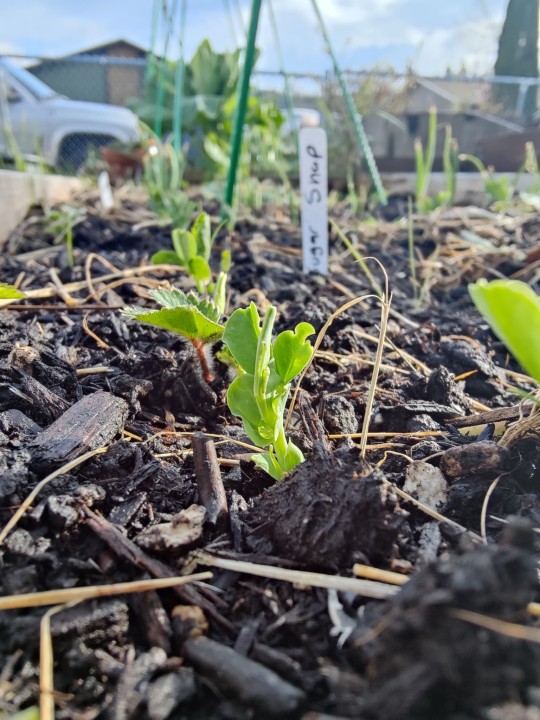
Last year I sleep walked through the years garden and it showed. The harvest was raggedy and the plants suffered. Instead of planting garlic and cold hardy vegetables I decided to let the garden rest under a cover crop over the winter. I have since dug it under and planted out the onions garlic and peas that will tolerate out cold wet springs and have started out warmer weather plants in the pop up greenhouse I put where our almond tree used to be after it was knocked over during a pretty bad ice storm that left the town without power for a week over the winter. I also started a no dig bed in the back yard where I hope to grow potatoes and corn. I covered the grass in cardboard then a layer of compost from our bin that's been left alone for about 2 years then a layer of soil and finally a thick layer of hay. It's rough and ugly but its not finished yet and if it grows food I'll consider it a great success.

9 notes
·
View notes